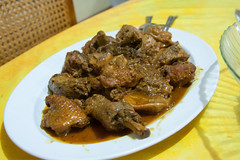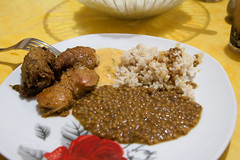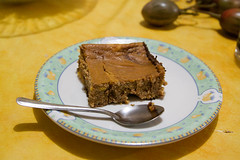Once we left Hermitage-Les-Bains, almost all of our remaining lodging on Réunion consisted of various gîtes. The “gîte” is a bit of a French-specific concept, but it basically means “guest house”, and the concepts ranges ranges from simple “gîtes a la montagne” (mountain huts providing little more than a meal, a bunk, and a blanket), to nicer “gîtes rural” (simple guest rooms), to elaborate Chambre d’Hôtes” which are like fancy bed and breakfasts. In Palmiste Rouge we stayed at a pretty good example of a “gîte rural”: Domaine Papangue, a beautiful home in the mountains of Cirque de Cilaos, which was outfitted with a small guest house with four very simple bunkrooms, a pool, and an excellent view (a product of a most adventuresome drive down the canyons and back roads of Palmiste Rouge).
Domaine Papangue also had splendid hosts, who cooked us a fabulous dinner, taught us a bit about the island’s culture Creole cuisine (despite a modest language barrier), gave us hiking advice (of the cautionary sort, “Can I see your route on a map? Seems tres sportif! Are you sure?”), and even let us leave some luggage with them while we hiked. And, in what was a rather common occurrence throughout our Réunion travels, marveled at the fact that we were Americans, since Americans almost never show up in Cilaos.
Every night, Domaine Papangue offers up a dinner to guests, and it’s rather a treat. We were the only guests, so they Starting around 4pm after offering us up some mint tea, our hosts were then spotted bounding about the property collecting various fresh herbs and vegetables for dinner: verbena, rosemary, mango, guava, and a unique one to us, “tomate arbuste”, or bush tomato, a thicker-skinned cousin to our tomato. And then for the next few hours quite a few pleasant aromas kept emerging from their kitchen. Indeed, one of the things I already miss about Réunion is that, if you are in any sort of residential area around 6pm in the evening, you are constantly bombarded with the smells of everyone cooking up various carris in their (usually open-air) kitchens.
Since we were the only guests that night, our hosts joined us for dinner, and carefully explained each course to us. They explained that since we were relatively new to the island, they were serving us what they’d normal cook for themselves on a normal night, the standard Creole dinner: a carri, a rougail, lentils, and rice. And I’ll have to say, the carri poulet served up to us at Domaine Papangue was easily one of the most enjoyable carris we had on the island: rich, flavorful chunks (and I mean chunks, the standard Creole way of butchering is basically hacking up the chicken with a machete) of a very dark meat, open-grazed chicken, simmered down in a rich tomato sauce just teeming with cardamom, thyme, and rosemany, and even a bit of cinnamon. Unlike a lot of other places we dined, the rougail here was on the sweeter end of the spectrum, made primary from mangos and the tomate arbust, for a rich, tangy, and slightly sweet addition that paired very nicely with the rice, lentils, and carri.
The lentils were also worth talking about: despite the extremely hilly, heck, mountainous terrain of Cilaos, one of their major activities in the area is farming, and one of the major product is lentils: if you know where to look, there are entire hillsides covered with short little lentil plants. And the small, compact lentils (very similar to the lentilles du Puy of mainland France) are a particularly pleasant product: compact and flavorful with a distinct nutty flavor. And if there is one thing I learned from almost every restaurant and gîte in Réunion, it’s that I need to refine my bean cooking skills, since these lentils were prepared just to the point of not quite falling apart, served up in a wonderful savory sauce.
Dessert was also nice: a sweet potato cake also packed full of spices and herbs. This meal was definitely one where I realized that, with the notable exception of rice, Réunion has a surprisingly diverse and largely self-sufficient agricultural system: the primary foods eaten on the island are, substantially, grown and harvested on the island (as we would see several days later over in Saint-Benoit, they’ve got some wonderful farmers markets as well).
Add in the extremely wonderful hospitality of our hosts (who gave us much advice about the area, were very patient with our language gap, and even let us store some of our luggage while we were hiking), and Domaine Papangue is definitely on our repeat visit list.





